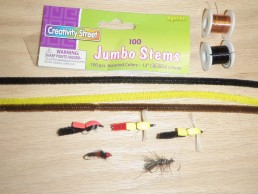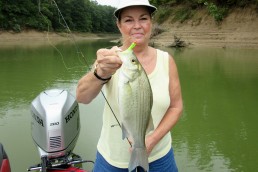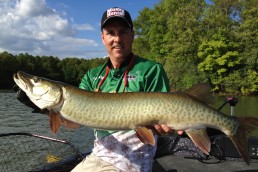Dainty Damsels and Darting Dragons
SHARE THIS POST
Two of the more ubiquitous insects found around water are the dragonfly and the damselfly.
Damselflies tend to be smaller, and when at rest they fold their wings over their bodies. Dragonflies get larger in size and extend their wings perpendicular to their bodies when they are at rest. Both have iridescent bodies and clear wing membranes. Both are widespread across North America, and start their lives as eggs that are deposited in water. They then hatch into nymphs, which are similar in shape. They live in the bottom substrate for a time before completing their metamorphosis into adults.
These both eat mosquitoes, and during reproduction the females use their ovipositors to lay eggs either in or on plants or directly on the surface of water. Entomologists know more similarities and differences, but for a fly fisher, this will suffice.
I am interested in the nymph as a wet fly and in the adult as a dry fly. From a fishing standpoint, mayflies all hatch and reproduce at the same time and are done for the year. However, dragons and damsels can live as nymphs for over a year. And adults can live the entire summer, reproducing several times. This means that both nymphs and adults are present at the same time all summer long.
I am a practical fly tyer, so I don’t really differentiate between the two species when tying. I am also more interested in fast tying to a close approximation rather than to a slower and tedious exact representation. The fish don’t seem to care that I use foam, peacock, hackle, pipe cleaner or wrapped deer hair—they just bite.
The nymph
Probably the easiest, quickest nymph is some sort of wooly bugger creation. You can use yarn, chenille, marabou, peacock hurl or dubbing in colors of green, black or brown to match the bottom substrate. These can be weighted either with wire, bead or dumbbell eyes. I am fishing lead-free as much as possible, so I use nickel, copper, or steel wire and brass or plastic beads and eyes. Since both dragons and damsels moult several times before becoming adults, any hook size from 12 to a 2 will work.
A second easy method is to tie wire and a straight fur (squirrel, deer) at the bend with the tips extending beyond just the bend. Secure the fur at the eye and then wrap the wire forward around the body and secure it. This makes for a more streamlined, “tight” appearance.
Are you enjoying this post?
You can be among the first to get the latest info on where to go, what to use and how to use it!
Adult dragon (damsel) flies
I tie to replicate the general silhouette and color of the insect—not to make an exact replica. For these simple flies, I make just the body, which extends past the bend of the hook and the thorax. This is the thicker part where the wings are found.
The body is traditionally made with a straight fur tied at the bend so that the tips extend a shank-length or more past the bend. The fur is then wrapped to consolidate it into a compact body. For me, this is too tedious. Instead, I use some of the following: a piece of “craft stem” (aka, pipe cleaner), any stiff material such as a paper clip, coffee stirrer, or quill that can then be wrapped in yarn, chenille or dubbing, or with a long piece of thin foam. The thorax is just foam or more yarn. The wings are made of a stiff material: fur, plastic or flash-a-boo. Again, I tie for the basic shape and color. Adults in both species are colorful, so bright greens and blues or brassy yellows are always good.
Fishing the flies
Unlike mayflies, which rise up through the water column when they metamorphose into full adult form, dragonfly nymphs move along the bottom until they can emerge at the shore or from rising vegetation where they become full adults. You should fish nymphs close to the bottom and near weed beds.
Both dragonflies and damselflies are voracious insectivores (eat other flying insects). Unlike adult mayflies, which emerge, mate, deposit eggs and die all over the water, dragons and damsels live relatively free of water as adults, so fish seldom see them. They are seen near the surface only when laying eggs or when there is a hatch of mosquitoes or other insects. However, this doesn’t mean that you can’t fish adult representations. Fish see these insects as darting silhouettes that seldom rest on the surface.
There is the potential of twisting a leader and tippet. To keep this twist to a minimum, I only use one back cast, just enough to raise the fly from the water and place it in a slightly different location. I let it sit for only a couple of seconds and recast with no line extension. Trout are the obvious targets, but I have caught many bass too.
My tying philosophy is, “I don’t want to spend more time tying the fly than fishing it.” These flies take less than two minutes to tie and can easily be done at a lakeside with a minimum of materials and effort.
MWO
SHARE THIS POST
Did you enjoy this post?
You can be among the first to get the latest info on where to go, what to use and how to use it!
Doug Thalacker
Doug Thalacker has a Masters of Environment Science from UW-SP and taught high school environmental science and earth science. He has outdoor/wilderness training through Outward Bound and American Red Cross. He has a lifetime of enjoying any activity that involves fields, woods or waters.



